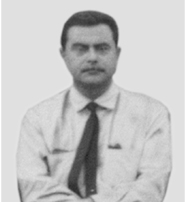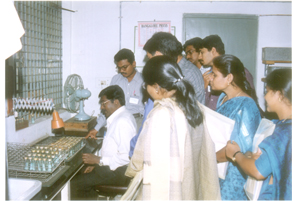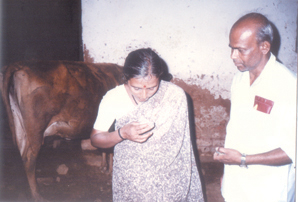3. IN THE WAKE OF KNOWLEDGE
3.7. Expanding horizons of research
A careful review of Annexure II would surprise scholars of any discipline as to the rich diversity of the protocols considered, research studies conducted, new paths traversed and papers published. Some of them, Evaluating TB as a health problem (RP/74) may look mundane. Was this study required when there were so many other pressing ones? Others, Assessment of training at NTI (RP/99) may appear daunting. Do you have to be self-critical already? Some, Incidence of cases at shorter interval survey (3 months) (RP/101) may raise eye brows. Can one really find new cases in such a short time? How many can be found? Even if found what can be done? Some, Action taking study (RP/54) may seem to possess utilitarian value. Some, the Longitudinal survey (RP/33-45-73,80-89,93) must be necessarily undertaken. Some, Integrated records and reports for health institutions (RP/108) may seem redundant. Why should a study of this sort be done here? The study, The role of multiple sputum examination (8-10 specimens) (RP/103) may seem unnecessary. Should you repeat the same examination time and again? Is it not going too far?
But this sort of over critical temper mellows when one is working with a disease like TB. Realistically, TB is a hardy and problematic disease. There may not be one single truth or a simple formula applicable in public health approaches. People in reality translate into groups or communities consisting of persons of different age, sex, backgrounds and customs. There can be ever so many constantly changing determinants. To determine what is required from such groups, demands great understanding and observational skill. Fortunately, from the operational studies conducted both in training and research fields, the NTI had acquired knowledge and experience.
Therefore, everybody concerned became flexible. Devotion to work became a byword. Team spirit was easily achieved because everybody did a bit extra till a goal was achieved. As a result, the total knowledge pool grew deeper and broader. Some of the best research studies completed, innovative methodologies discovered, implemented and papers published were during the first 15 years.
Till they left, Dr Raj Narain and after him Dr Gothi, were piloting all research studies conducted by the EPS. There were many investigations too, of short duration, examining a specific issue. For e.g. the Tumkur prevalence survey published in 1963 had shown that 14% of the bacteriologically confirmed and 23% of radiologically active TB cases gave negative reactions to 1TU RT23 with tween 80 at less than 9 mm level. This was somewhat puzzling. How can such cases be tuberculin negative? A short study, therefore, was carried out among 131 patients in a TB sanatoria using the same tuberculin. The reactions were read successively on the following 10 days. A fresh X-ray was taken for the patients who were able to come to the unit. Their sputum was examined for acid fast bacilli (AFB). The results showed that a very small percentage of TB patients were tuberculin negative and readings beyond four days did not add much to the information content68.
Several papers were published in the area of treatment. In 1965, V.Govindaswamy and D. Savic presented a paper which stated that there will be some difficulties among the DTC personnel themselves in accepting the principle of intermittent regimen due to personal prejudice.A considerablec portion of patients were also lost due to irregularity in accessing treatment69. In a paper on collection and consumption of drugs, published in 1971, it was found that among patients who collected the drugs regularly, 70% of them consumed and achieved a high degree of bacteriological quiescence70. In the paper published in 1973, Place of contact examination in a TB programme, Nair and Gothi could not justify the inclusion of contacts of TB cases as screening population for case finding until the potential yield of cases from symptomatic out-patients was fully utilised. Contrary to the currently held belief, examining the contacts of cases for TB would yield small number of cases. It would add heavily to costs and therefore would not be an economically viable method71.
Several important papers were published on the programme development. In 1967, Baily and others published the paper, Potential yield of pulmonary TB by direct microscopy of sputum in a district of south India. The authors estimated that about 45% of the total estimated prevalent pulmonary cases in a district could be diagnosed in a DTP during one year, if all PHIs functioned according to the programme recommendations. The work load due to the TB programme could be managed with the existing staff72. The paper was so influential, several countries followed its design and conducted studies. Dr Jagota repeated it 30 years later. The findings were similar73. Upon learning this Dr Baily commented: “I am happy that the study was repeated 30 years later. But I am not happy because the findings remain the same which means that there is no improvement in the programme."
Three years later, in 1970, two important operations research papers were published. Nagpaul and others conducted a socio-economic study of out-patients attending a city TB clinic to judge the place of specialised centres in a TB control programme. They found that distance, socio-economic value of the patient to his family, quality of service rendered by the centre tended to be factors responsible for patient attendance, even if the patient was suffering from symptomatic discomfort and was aware of it. Rural dispensaries occupied a favourable position in the programme since they operated under a more coordinated system than city dispensaries74. In the same year, Gothi and others published the paper showing that a fair number of old and new TB patients contact the GHS even in a city and therefore, the GHS could contribute to case finding activity75.
The role of NTI with regard to treatment has always been to find a chemotherapy regimen with higher efficiency and acceptability for the programme. Therefore, its perspectives are larger and varied than that of TRC, Madras. Before a treatment regimen is recommended for mass use under a programme it undergoes evaluation in at least three stages. At the first stage, controlled clinical trials of the drug regimen testify to its efficacy under ideal conditions after ensuring that every patient put on treatment consumes most, if not all, the prescribed doses of chemotherapy within the stipulated period. In the second and third stages of evaluation, regimens are studied for wide spread of applicability on a routine basis. The second tier consists of the potential efficacy, when all the programme recommendations are satisfied; efforts invested are no less and no more. In the third stage, the regimen is actually introduced in several units of the NTP on a pilot basis and carefully monitored with selected indices over a period of time to assess its success and shortcomings on a large scale.
In 1974, Baily and others measured the potential efficacy of two standard DTP drug regimens of one year duration, the daily self administered Isoniazid and Thiacetazone (TH) and supervised twice weekly Streptomycin and Isoniazid (SHTW). In this study, 60% of the patients who received treatment on TH and 68% of those initiated on SHTW were bacteriologically negative at the end of one year. This was opposed as against sputum conversion rates of 82% and 94% respectively obtained in controlled clinical trials of these regimens. A loss in bacteriological conversion in about 20-30% of patients were observed in clinical trials to their use in the programme conditions76.
Attention was also paid to the requirement of treatment for smear negative, radiologically active pulmonary TB cases (suspect cases). During 1979 Aneja and others reported the finding of a study of 457 suspect cases and found that only half of the suspect cases put on treatment actually required anti-TB treatment. The other half were either non-tubercular or had burnt out TB shadows in the chest. The study further revealed that for those suspect cases requiring treatment TH regimen was not sufficient and they needed a more potent regimen77.
In addition to the voluminous studies in major fields, NTI also conducted scores of limited objective pilot studies. For e.g., in 1964 it conducted tuberculin testing of cattle (300 buffaloes and cows) with both mammalian and avian tuberculins. A short report was published in the NTI Newsletter in 1964. The findings showed that the prevalence of positive reactions in buffaloes was 80% and in cows 0.5%. The results were not conclusive. However, very few humans had reportedly developed a disease from the M.bovis strain despite the observed close contact between humans and cattle. Not a single bovine strain was isolated from 300 positive cultures from another study carried out among humans in the neighbourhood78.
|
|
|
|
|
|
The above study was made possible because of the induction of Dr N Naganathan as Jr. bacteriologist, who was a trained veterinarian. He rendered invaluable service to the work of that section through his tenure. He was responsible for shifting the entire laboratory from the cramped quarters of the main building, to its newly built premises.He also initiated action in establishing an animal house to breed guinea pigs and other animals needed for experimentation.
During those early years, the bacteriology section undertook several studies and exercises to evolve a robust methodology suitable for a reputed lab of a large developing country. Robustness implies maintenance of high and accredited standards in laboratory procedures, processing of data and reporting. Since the functions also included teaching and field work, some investigations went beyond the four walls of the laboratory. For e.g., what will be the fate of the specimens collected in different locations at intervals of 24-48 hours? What guidelines are to be followed in the collection of a sputum specimen and its despatch to a central laboratory from distant locations? What would happen if the processing of smear and culture of specimen got delayed between 1-7 days? What would be the increased yield of cases by introducing culture examination over smear examination only? Is the cold staining method using carbol-fuchsin containing chloroform as efficient as Ziehl Neelson (ZN) method? Would there be inter and intra reader variation in direct microscopy casting influence on sensitivity and specificity? What is the prevalence of drug resistance to major anti-TB drugs in different epidemiological situations - (i) sanatoria, (ii) urban TB clinic, (iii) rural GHS, (iv) mass case finding among select groups of population and (v) survey of general population? What would be the cost of establishing and operating a TB bacteriological laboratory? What are the likely costs of one smear examination vis-à-vis culture and sensitivity tests?
In 1970, a very important paper: Bacteriological diagnosis of pulmonary TB – sputum microscopy, was published79. Some of the issues examined were: (i) different criteria adopted for examination, (ii) different epidemiological situations from where the sputum specimen was collected, (iii) sensitivity and specificity of sputum microscopy technique adopted, (iv) experience of the trained technician, etc. Observations revealed that several factors like: (i) quality of sputum smear, (ii) time spent on smear examination, (iii) type of sputum specimen, (iv) use of multiple smears, tended to influence the results79.
The NTI laboratory was doing quality work which matched national and international standards. In 1974, NTI laboratory work standards were comparable to the TRC, Madras. Specimen classification of the NTI laboratory was matched with the TB Laboratory of the Communicable Diseases Centre (CDC), Atlanta USA. The results showed that the standards of the NTI laboratory favourably compared with these two institutions. The same year, Dr Naganathan published an article: Some guidelines for establishing a TB culture laboratory.|
|
|




